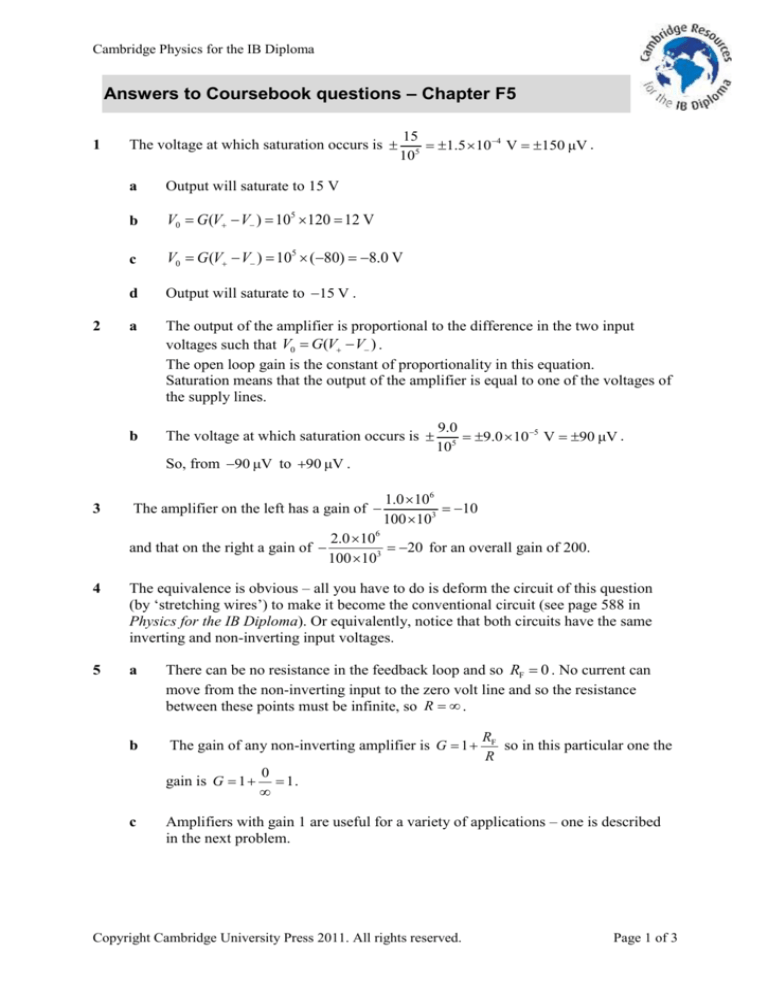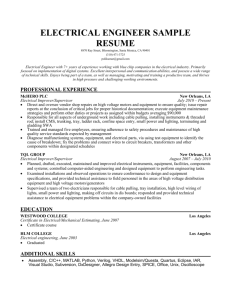
Cambridge Physics for the IB Diploma
Answers to Coursebook questions – Chapter F5
1
2
The voltage at which saturation occurs is
a
Output will saturate to 15 V
b
V0 G (V V ) 105 120 12 V
c
V0 G (V V ) 105 (80) 8.0 V
d
Output will saturate to 15 V .
a
The output of the amplifier is proportional to the difference in the two input
voltages such that V0 G(V V ) .
The open loop gain is the constant of proportionality in this equation.
Saturation means that the output of the amplifier is equal to one of the voltages of
the supply lines.
b
The voltage at which saturation occurs is
So, from 90 μV to 90 μV .
3
15
1.5 104 V 150 μV .
105
The amplifier on the left has a gain of
and that on the right a gain of
9.0
9.0 105 V 90 μV .
105
1.0 106
10
100 103
2.0 106
20 for an overall gain of 200.
100 103
4
The equivalence is obvious – all you have to do is deform the circuit of this question
(by ‘stretching wires’) to make it become the conventional circuit (see page 588 in
Physics for the IB Diploma). Or equivalently, notice that both circuits have the same
inverting and non-inverting input voltages.
5
a
There can be no resistance in the feedback loop and so RF 0 . No current can
move from the non-inverting input to the zero volt line and so the resistance
between these points must be infinite, so R .
b
The gain of any non-inverting amplifier is G 1
gain is G 1
c
RF
so in this particular one the
R
0
1.
Amplifiers with gain 1 are useful for a variety of applications – one is described
in the next problem.
Copyright Cambridge University Press 2011. All rights reserved.
Page 1 of 3
Cambridge Physics for the IB Diploma
6
a
The voltages across the two resistors are equal and add up to 6.0 V, so
each is 3.0 V.
b
The total resistance of R2 and the voltmeter is
1
1
1
so RT 0.5 k .
1.0 1.0 RT
Now the voltage across R2 and the voltmeter is half that across R1 .
The two voltages still add up to 6.0 V, so the reading of the voltmeter is 2.0 V.
The voltmeter reads the ‘wrong’ voltage – which we expected to be 3.0 V.
This is because this voltmeter does not have an infinite resistance, i.e. a resistance
much higher than that of R2 .
7
c
The voltage at the non-inverting input is 3.0 V. The amplifier has gain of 1 and so
the output voltage (which is what the voltmeter reads) is 1 3.0 3.0 V .
a
We are assuming that the voltage at point V is that of earth, i.e. zero.
b
See page 586 in Physics for the IB Diploma.
c
The current through resistor R1 is
d
The amplifier can now handle a much greater range of input voltages since the
output depends logarithmically on the input voltage.
Vin
. We are told that the current through RF
R1
V
kV
kV
equals I I 0 e I 0 e 0 . The two currents are equal and so in I 0 e kV0 .
R1
V
V
1
Taking logarithms gives ln( in ) kV0 and hence V0 ln( in ) .
I 0 R1
k
I 0 R1
8
The gain of the amplifier is 1 (see Q5 and Q6). Thus the voltmeter reads the potential
difference across the capacitor. Since the potential difference is proportional to the
charge on the capacitor, the voltmeter can be calibrated to read charge; in other words it
becomes a coulombmeter.
9
a
The voltage at X is 0 by the virtual earth approximation.
b
I
c
The gain of the amplifier is G
V 4.00 103
0.016 106 A 16 nA .
3
R 250 10
500
2.0 and so V0 2.0 4.00 8.0 mV .
250
Copyright Cambridge University Press 2011. All rights reserved.
Page 2 of 3
Cambridge Physics for the IB Diploma
10
11
15
15 3.0 V .
15 60
a
The voltage is (using the potential dividers idea)
b
To saturate the output at 15 V the non-inverting input voltage must fall below
3.0 V. Assuming a voltage of 3.0 V at the junction between the 4.0 and 8.0 k
resistors means that the current through the 8.0 k resistor will be
12
1.5 103 A and the potential difference across the 4.0 k will be
8.0
4.0 1.5 103 6.0 V . This means that the input voltage must then be
3.0 Vin 6.0 Vin 3.0 V so the input voltage must be reduced by 9.0 V.
At t 0 the voltage at the both inputs is zero. As time increases, the voltage at the noninverting input is positive and therefore greater than the voltage at the inverting input.
The output is positive and so current can move down through the diode. The potential
difference across the capacitor is equal to the voltage of the input signal.
At t 0.5 s this potential difference is equal to the maximum input voltage, Vmax .
The voltage at the inverting is also Vmax .
After t 0.5 s , the voltage at the non-inverting input will be less than that at the
inverting input. Therefore the output will be negative and no current will move through
the diode. This means that the voltage across the capacitor will remain to be Vmax .
12
32
2.0 and so the output is V0 2.0 4.0 8.0 V .
16
a
The gain is G
b
The maximum input voltage is 4.0 V and so the output never saturates. Thus we
will have a graph that is 2.0 times the given graph (see page 814 in Physics for
the IB Diploma).
c
With a power supply of 6.0 V there would be saturation at
6.0
3.0 V .
2.0
The graph would then be something like:
V/V
6.0
t
-6.0
13
The Schmitt trigger uses the comparator property of an op-amp (i.e. the output depends
on whether the input signal is smaller or greater than a reference voltage value) except
that there are two reference voltage values that the input signal is compared to. There is
one value when the input signal is increasing and another when it is decreasing.
Copyright Cambridge University Press 2011. All rights reserved.
Page 3 of 3









